In June Mother Longenecker and her daughters Marian and Janice created butter-shaking memories in a two-quart jar, making butter using three easy steps:
- Pour cream into 2-quart jar.
- Shake until you rattle and roll.
- Remove the congealed mass from the jar. Add a pinch of salt.
In July, my Southern friend Carolyn honored my birthday in a “Shake-Rattle-and-Roll Butter-Shake” party. Today you can open up an old-time textbook with me and behold first-graders learning about butter making in a reader published by Lyons and Carnahan with the copyright dates spanning the years 1927-1936.
Interestingly, the Child’s Story Reader also lists three simple steps for butter making expressed in first-grader language:
We got the cream from a cow.
We put the cream in a jar.
We shook the jar.
Jack and Jane even added a pinch of salt to the mixture, and afterwards they had a party of butter on bread!
Another page shows a recipe for butter milk made with a churn with Aunt Ellen assisting.
More Moments of Discovery
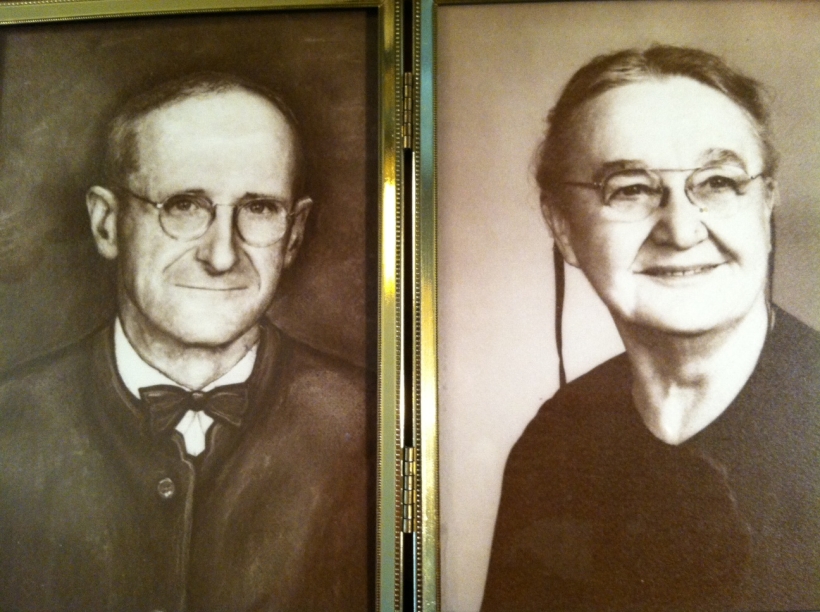
Henry Risser Longenecker, referred to by friends and family as H. R. or “Hen,” was my grandfather on Dad’s side of the family. He died when I was five, but I have a distinct memory of him killing a snake in the grass with a long stick. Like my father, he was a doctor of motors interested in steam engines, Model A Fords, and farm equipment. Until I unearthed his autograph book, I had no idea he had artistic leanings as revealed in his autograph book. Autograph books, common in classrooms in the 1800s, contained signatures, artwork, and bits of poetry. According to Folklore: An Encylopedia of Beliefs, Customs, Tales, Music, and Art, Vol. 1 (edited by Thomas A. Green) autograph books, existed as early as the fifteenth century and were seen as “a mark of gentility until the beginning of the twentieth century.”
The cover of Henry Longenecker’s autograph book reveals artistic flair with a faint inscription of a great virtue taught to every school child, the word Truth visible if you squint carefully at five faint letters appearing close to the embossed yellow flower.
The dedication appears in flowing cursive penmanship with a dove’s beak clasping Cupid’s arrows
Painted artwork, still-brilliant, graced most pages like this one, complete with signature and date.

Autograph books tell us several things about students in the late 1800s:
1. Penmanship was taught and valued as an artistic skill.
2. Friendship and learning were intertwined. Both were expressed as an art form.
3. Students took great pride in their work.
* * *
What else can these books teach us?
Coming next: What color makes you sing?
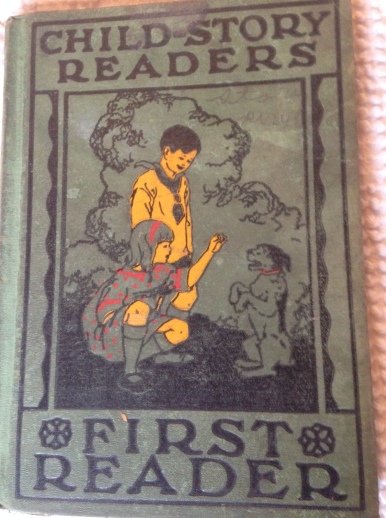
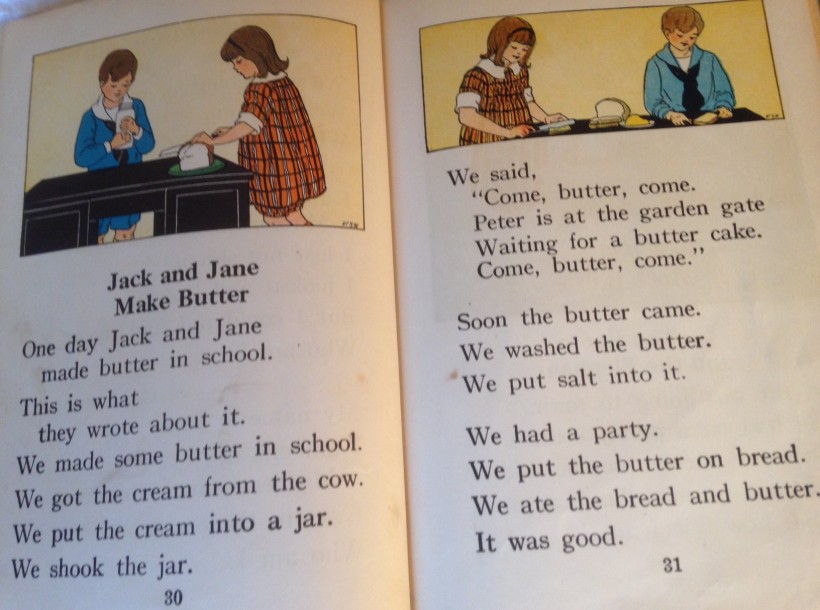
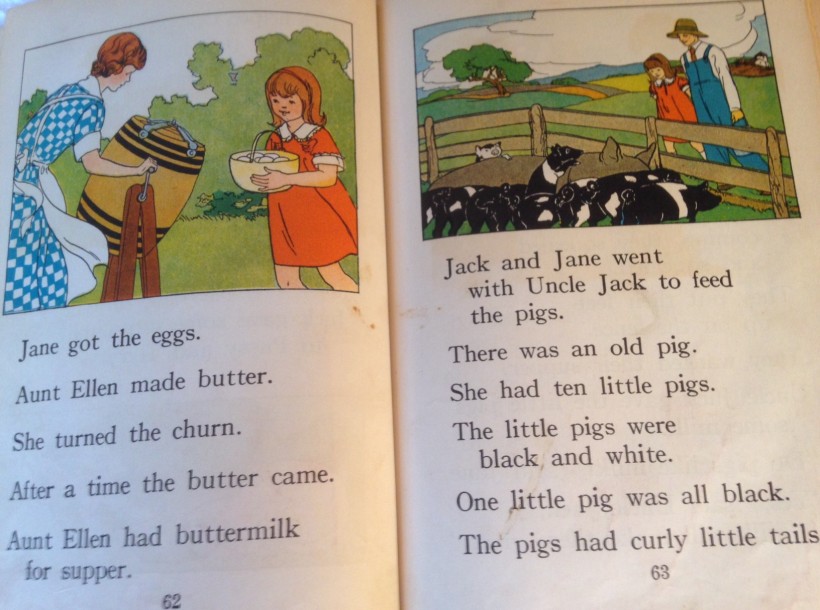

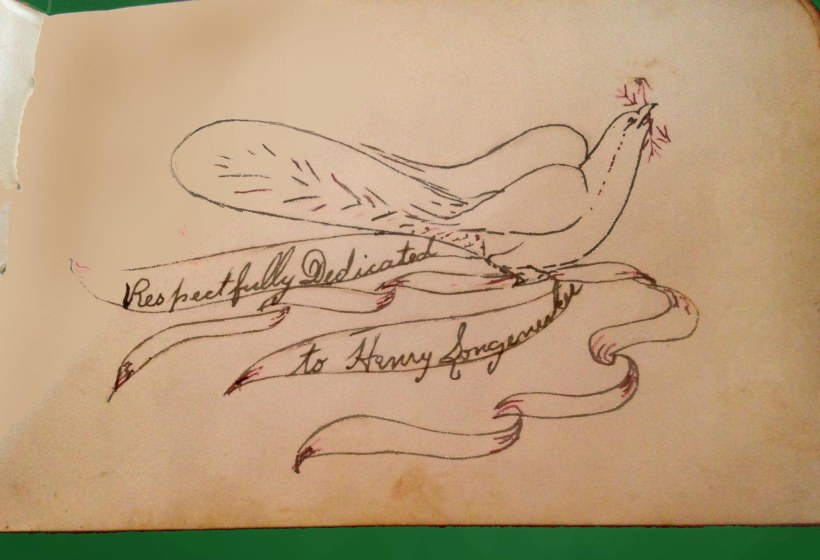
Your post on making butter with mom and Jan was great with the pictures you included. Also your birthday party of making butter and dancing was another fun and wonderful pictures. Now the books of children making butter are a wonderful reminder of how the older children books were great at reading.
The pictures of Dad’s parents are great treasures of your family. Your so blessed to have all these memories and history. Thank you for sharing all of this with us. Penmanship was so beautiful back then. So sad that our children don’t get the same teaching today. Thank you again for your post.
Gloria
LikeLike
You are up early, Gloria, reading this post. I imagine you, an early riser, have already had your devotions and breakfast though.
Except for my grand-parents, you can visualize all the others. We’re are so glad you are part of our family history. Thanks for posting today.
LikeLike
What a great post, Marian! I remember your butter posts, and I think I commented then that when I taught preschool, I had the kids make butter. Then it became a Thanksgiving activity for my daughters. My younger daughter will probably still want to do it this year. 🙂 Thank you for sharing the Jack and Janet excerpt, too.
The autograph book–wow, what a cool thing to have! Do you think there is any connection to the Fraktur tradition among Pennsylvania Germans?
LikeLike
Merril, you are reading this with the rich context of American history before this era, having just published your history of everyday life during the American Revolution. (Readers, click on Merril’s photo to get an idea of the variety of her publications, this being her tenth book/encyclopedia. Simple amazing!)
I have no idea whether there is any connection between autograph books and the Fraktur tradition among the Pennsylvania Germans. I suspect that autograph books were prevalent beyond that culture and as such typical of the era. Like you, I marvel at the artistry in children so young. Thanks so posting once again, Merril.
LikeLiked by 1 person
Thank you for the promo, Marian! 🙂 The book isn’t actually published yet. I’ve just submitted it to my editor at ABC-CLIO.
LikeLike
It’s on the horizon though. We’ll wait with anticipation for approval of final proofs, Merril.
LikeLiked by 1 person
This is the first post of yours I have read. I Love it. I am tempted to shake up some butter!
LikeLike
Dor, you are an early bird too. Thanks for reading and commenting. As you can see, we got carried away with the butter shake with Mother in Pennsylvania and then the party with my girlfriends in Florida. Unfortunately, my mother passed away just a little over a month after this video was recorded.
Yes, join the crowd, get into the butter shake business too. And do visit again soon. You never know what you will find here!
LikeLike
Oh what I would give to have the autograph book I used in grade school. We had them in the 50s in Middlebury Ind. I’m assuming from this post that you didn’t use them to collect signatures and little ditties from your friends? Kind of like the back of a yearbook but independent. Some were funny little poems, others sentimental. Later we had “slam books.” Obviously this post brought back a bunch of good stuff, Marian. Thanks–and I must try the butter experiment with my grandsons when they get bigger! Love the Jack and Jane story. We only had the Dick, Jane and Sally books. 🙂
LikeLike
A few days ago my sister Janice found her autograph book but there were just a few signatures with little ditties, as you say. Like you, we collected good wishes and autographs in the back of our yearbooks. I never heard of “slam books.” Good-natured digs?
The reader pictured is ancient. I remember Mac and Muff books; my sister had Dick, Jane and Sally. All good stuff with marvelous illustrations!
LikeLiked by 1 person
You have sparked a lot of memories and a few new ideas for me, too, Marian. I think it might not be too soon to make butter with Owen and Julia, especially since Uncle Nik and Aunt Kate can help “shake, rattle, and roll.” So, thanks for this reminder of your earlier fun posts.
I used to love to read the old autograph books my mother stored in an empty room on the Spahr farm. And like Melodie, I had one of my own. Today none of them exists in physical form.
But I still have the memories, and I wrote and spoke about them as a college president. For some reason, I failed to include them in my memoir.
You’ve given me a new blog topic. Memoir outtakes! Or overlooked Memoir Moments!
LikeLike
I am so glad this post sparked more new ideas for you. Author Janet Givens often posts “Deleted Scenes” from the chapters of her book that ended up on the cutting room floor. It sounds as though your writings and speeches as college president are almost ready to be re-born as blog posts too. (Like Laurie, I dispute the idea that you are lying fallow at the moment – ha!) Germination, incubation, marinating . . . all part of the strenuous process.
Grateful for your comment, Shirley, as always.
LikeLike
I think this would be such a fun activity for the younger ones at Thanksgiving dinner. Then we can scoop out what they make to put on the table. This is such a gem of a post with the grammar school primer, the autograph books, and I love the photos of your grandparents smiling.
I read about “memento mori” this morning and “memento vivere.” This is definitely an example of “memento vivere.” You are contributing so much to your family lore documenting in a clear and artistic way so that it lives on.
LikeLike
Thank you for the encouragement, Georgette. I have not heard the Italian (?) phrases you mention: “memento mori” and “memento vivere.” Yes, I like the lively “vivere” phrase better.
Let me know how the butter shake with the small fry works out. Could be a blog post for you!
LikeLike
Thank you for your post and the pictures. I think I know what my big churn was used for. It is large like the picture in the reader. The butter must have floated to the top and the rest was butter milk. The churn I have was in my Mother’s family and I bought it at the sale that Dad had. Really cleaned it up and now use it in our tv room with a lamp on the lid. Mine has a stand too. I love old primitive things. I think Mother would be surprised to know that I have that in “her house”.
LikeLike
Gerry, I’d love to see the butter churn you have re-fashioned into “furniture” in your TV room. Yes, my Aunt May would be surprised. Maybe you could picture it on Facebook sometime.
I appreciate your reading and commenting today, dear cousin!
LikeLike
Awesomeness! I have a couple of those little illustrated readers from my great aunt’s school. She was the first school teacher in my home county and a spinster. Sunnyside School was converted into a community clubhouse and they were tossing out the books. I taught my kids to read before school age on those little stories. In the Fact and Story Reader Book Three, there is a story about about milk, followed by a story about making butter.Then it moves to maple sugar time.
LikeLike
It makes you wonder whether the good old days weren’t really all they were cracked up to be. I love your story of those early books, making your kiddos into whiz-bang readers before they ever got off the school bus! Thanks, S. K.
LikeLike
I remember making butter as a child on the farm. Its so cool to see the early reader with a recipe for making butter. I love autograph books too. I have a couple of mom´s when she was a teenager.
LikeLike
It’s heart-warming to observe our parallel stories, Darlene. Thanks for stopping by today.
LikeLike
Marian — This post brought back fun memories of your two previous butter posts that both made me laugh! And it sparked a fond memory of my first reader that featured Dick and Jane.
Penmanship is important to me, not just because it was a prominent part of my elementary school education, but because with today’s technology, most of us whip our fingers across a keyboard so often that writing with pen and paper seems to be on the soon-to-be-extinct list. So taking the time to neatly handwrite a letter (usually to our son who lives 1,700 miles away) is something I make a point of doing regularly.
LikeLike
I hope your son keeps those letters. If not, you’ll have to insist on it. After all, you have to keep the family legacy going.
In our sorting / packing event, I have unearthed several of Mother’s packets of note cards, which I plan to use when I get my bearings at home again. Many of them are of the 1950s – 1960s vintage. We also have found letters sent in the same era bearing 5-cent postage. Wow, oh, wow!
Thanks for the comments and for the sweet tweet, Laurie.
LikeLike
Ha! So Jane had another partner before Dick?! (Or was she two-timing him?)
LikeLike
Too funny! Thank you, Kathy for that smart remark. Nice to see you again on “plain and fancy.”
LikeLike
I have several very old readers, plus ‘Dick and Jane’ and ‘Alice and Jerry’. They sent me on my way to love, love, love reading! Thanks for this excellent post! 🙂
LikeLike
The Alice and Jerry books are unfamiliar to me. Mac and Muff / Dick and Jane are all I knew. I’m getting an education here. Thank you, Anita.
LikeLiked by 1 person
My mother has a copy of this very book, and it looks exactly like your picture. I’ll have to thumb through it to find that butter-shaking story. Fun post.
LikeLike
I have to wonder whether your mother inherited this volume from her mother with its 1920-30s vintage. Do visit again soon, Kate.
LikeLike
Well, my mom was born in 1929, so I’m thinking it is her very own copy. 🙂
LikeLike
Golly, you look SO young, I had you pegged a generation later. Ha!
LikeLike
That’s so funny. Actually, I’m in my 40s. My mother gave birth to me when she was 41 and my sister when she was 43!
LikeLike
We had autograph books when I left junior school. People wrote little funny verses or good luck messages. As we don’t have yearbooks here I guess this was our way of remembering old friends.
LikeLike
You have took me back to being ten Marian we made butter at school too …what fun butter making parties .
Here in the U.K . our books were Janet and John. I loved them . I am an avid reader thanks to my Mum and school. Aren’t we lucky to have .education when so many in the world aren’t so fortunate .Your family seem so interesting .
Cherryx
LikeLike
It’s lovely to read comments from across the pond. I see there are many similarities. Thank you, Cherry!
LikeLike
We certainly do have things easy these days! Making butter must have taken a lot of time.
LikeLike
Life proceeded at a more leisurely pace back then. There were fewer distractions. I guess you’d say people didn’t miss what they didn’t have. Ha!
LikeLike
I regret that they no longer teach cursive writing or penmanship in school. It is fast becoming a lost art!
LikeLike
My son teaches his middle-school art students to write in cursive. Obviously, texting has made penmanship well nigh obsolete. Thanks for commenting, Jenn.
LikeLike
Lovely memories, Marian. I don’t recall ever making butter, but I do remember squeezing some orange fluid into a mixture to add color to the oleo (margarine). That’s back when butter was considered to be bad for your – cholesterol, and all. Now it’s margarine that’s the bad guy. (trans fats)
My father had beautiful penmanship. I remember having to practice cursive writing when I was in elementary school. Regretfully, gone are those days. 😉
LikeLike
Yes, I remember those orange squeeze bags used to add fake color to margarine. I’m trying to recall whether we blended it with a mixer or with our hands. Hmmm . . .
Yes, penmanship was highly esteemed when I went to school too. I remember practicing swirls and slanted lines in our Zaner-Bloser penmanship books. Those were the days!
LikeLiked by 1 person
Yes, those were the days when we could READ what others wrote. 😉
LikeLike
What a lovely post from the past. You certainly have enough wonderful memories to make many books Marian. This also reminded me about how penmanship was very important. I remember my own grandfather telling me when he was in school, he was a lefty. The school teachers used to hit leftys on the knuckles with rulers and make them write with their right hands; at least that was the case for him. He remained ambidextrous all his life but remained writing with his right hand.
LikeLike
Yes, Debby, I realize I have been blessed with many childhood memories and artifacts to go with them.
Yes, again. Education was very unyielding and strict in “the olden days.” However, my teacher in grades 1-4 (who was also my Aunt Ruthie) was a lefty and so never penalized students for being left-handed. But I do know even then there was a strong bias toward right handedness. Now I don’t think teachers make an issue over which is the dominant hand in their students.
Your comments always appreciated!
LikeLiked by 1 person
I enjoy your stories Marian. And perhaps the rules had eased up when you were in school; you’re just a spring chicken, lol. My grandfather was in school decades before you. 🙂
LikeLike
😉
LikeLiked by 1 person